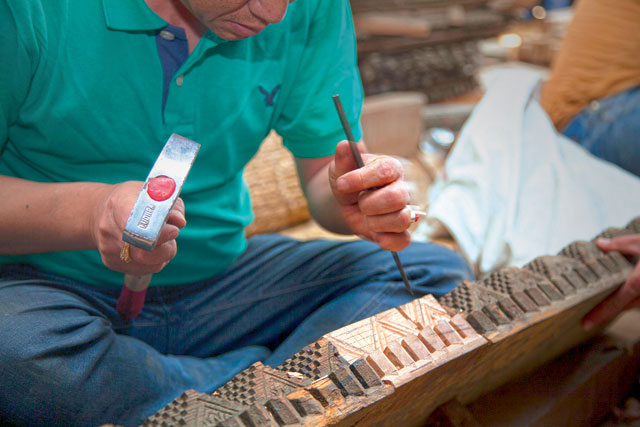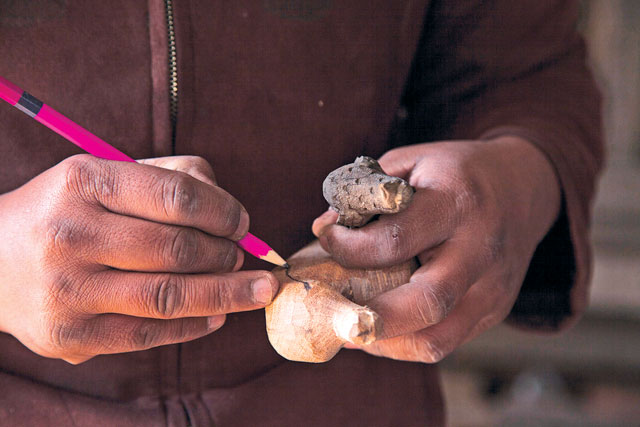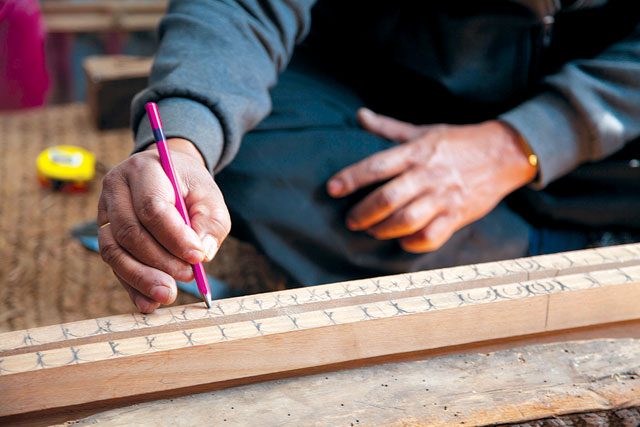
We observe a simple but powerful grassroots project that is bringing people together to restore and preserve past beauties.
In the April 2015 earthquake, we didn’t just lose monuments, temples, and heritage sites. Another, less heralded casualty were the countless private homes—many of which held irreplaceable artifacts within their structure, particularly carved wooden windows, beams, and other items.
If you find your way inside the courtyard of Itum Bahal, which is a quiet oasis in the middle of bustling activity, you’ll see an odd looking structure that resembles a small barn. It’s not filled with livestock, though, but with people, and wood. Here, Shriju Pradhan and her team of craftsmen and volunteers are hard at work on a 45-day restoration project.

Pradhan works for the Kathmandu Metropolitan City, but even more than that, she works for the preservation of Kathmandu’s culture and heritage. Talking to her, I was impressed by her simple sincerity and dedication to her cause. She loves these beautiful old buildings and the history that they represent, and each day from morning till night she does all she can to try to save them; in the process, she has to contend with both government regulations that exist but are not being enforced, and those who are looking at short-term gain by putting up shiny new commercial buildings.
When homes deemed unsafe after the earthquake had to be torn down for reconstruction, their owners were asked to save the windows and other carved wood items so they could be included in the new structures. But, there was no place to store them. “We have no shelter for ourselves, how can we make place for these large items?” people said—and it was a valid point. The locals at Itum Bahal are a community that cares deeply about heritage preservation, and when they heard about the need, they volunteered the space inside their courtyard to house the wooden beams and windows that needed storage, and now, restoration. Hotel Dwarika donated materials to build the shelter and help with the work. All in all, it’s been a team effort.

The preferred wood for making these items is from the sal tree, or the Shorea robusta. The sal tree has extremely hard wood, and in addition to being durable and weather resistant, it is also resistant to munching by insects. It grows in the Terai, and throughout the subcontinent, and is the preferred choice for Nepal’s craftsmen. The team showed me a carving that had been made from another lighter wood, and even to a layman, the difference was obvious. This was easy to pick up, and riddled with holes, where termites or other insects had been eating their way through it. Clearly not made to last like the other wooden items made from sal wood, which even though old, was strong and still looked remarkably good.
All around, people are cleaning, working. There are not many people who can do the actual fine restoration work, but the ones who can are training others to learn the skill, and with a little guidance anyone can clean and prep them.

On my second visit, I met Raj Man Bajracharya, from the Federation of Handicraft Associations of Nepal, who are partnering with the Kathmandu Metropolitan City on this project. He told me that they were able to tap into their database of craftsmen of all sorts to find specialists for this project. Most of them are Newars, and to my surprise, one is even a woman. The atmosphere is busier when I am here this time, with everyone hard at work on the job at hand. Less time to talk, but I don’t mind—there’s more opportunity for me to observe and learn. One man is sketching designs onto pieces of wood with a pencil: someone else is mixing sawdust and glue to make a filler for cracks in an old carving. Yet another craftsman has set out to repair a large, bite size hole in what is otherwise a beautiful strip of carving: a new piece of wood has been fitted into the gap, and he is now painstakingly carving the new part to match the old design on either side of the new insert.
It’s slow work, there’s tons more to do, and there are moments when their efforts might look like a drop in the bucket of what needs doing. But right here, and right now, progress is being made, and an important bit of the country’s history is being saved. That’s work well worth the effort.
If you’d like to learn more and join in the restoration effort and volunteer your time or skills, you can contact: culttour.div@kathmandu.gov.np or shriju.pradhan@gmail.com










